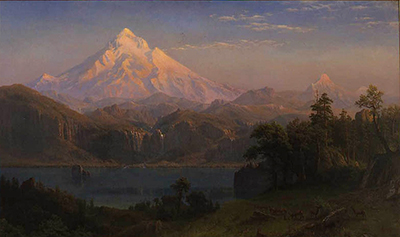Mount Hood is a painting by American painter Albert Bierstadt. Albert Bierstadt (1830-1902) is an American landscape painter who was born in Germany. He painted many landscapes of the American West, often featuring mountains.
Mount Hood (1863) is one such painting. It was painted in 1863, and it currently resides at the Metropolitan Museum of Art in New York City. The painting's primary features depict Mount Hood, Oregon's tallest peak, with several clouds hanging above it. A small lake is visible to an extent, but the emphasis of the painting is on Mount Hood.
Mount Hood is the only figure in the landscape. It's bathed in a vibrant ochre that gives it an ethereal quality while also making it look two-dimensional. The sky has a pinkish hue with diagonal brushstrokes that create movement and depth. The mountain's summit is erupting while the slopes are covered in snow. The painting demonstrates the characteristics of paintings from the Hudson River School, which includes vivid colours and enlarged vistas that depict themes of Manifest Destiny, where it was believed that America had a divine right to stretch across North America.
Albert shows how important the mountain is. Mount Hood is a mountain that rises to 11,239 feet (3,429 meters). It is located in the state of Oregon and is a stratovolcano. It is the highest mountain in the state of Oregon and has 11 active glaciers on it. It has been covered with at least 25 feet (7.6 meters) of glacial ice, which comes from several glaciers formed by Mount Hood's many eruptions.
Bierstadt was born in Solingen, Germany and immigrated with his family to America at 13. He studied painting under several artists such as Thomas Doughty and eventually became a member of the Hudson River School of landscape painters, an American art movement from 1850-1870. The school had two important characteristics that defined it; firstly, its members were fond of landscape paintings that used light to depict the beauty of natural landscapes. And secondly, they often travelled to discover new places and paint them as accurately as possible.
The composition of the painting also has a spiritual dimension as it depicts a mountain that stands higher than the other surrounding trees. This is similar to many of Bierstadt's paintings, which often depict mountains as if they were deities. The painting shows Mount Hood at sunset with an erupting summit and has a vivid colour palette that makes it stand out. He painted it and showcased his understanding of large panoramic landscapes of Western scenery. He's also recognised for painting the first-ever painting of Niagara Falls. You might also be interested in Thomas Cole, another landscape painter whose highlights included Voyage of Life - Childhood, The Course of Empire - The Pastoral State and Distant View of Niagara Falls.




